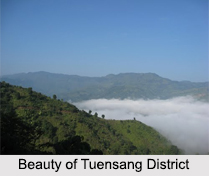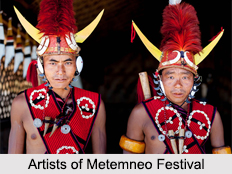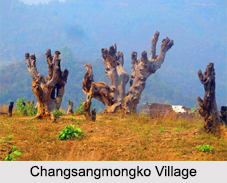 Tuensang District is one of the eight districts of Nagaland. It lies in the easternmost part of Nagaland, and is named after the village which is situated closed by the district headquarter. The district is populated by five major tribes namely, Chang, Sangtam, Khiamniungan, Yimchunger, Phom and a part of Sumi.
Tuensang District is one of the eight districts of Nagaland. It lies in the easternmost part of Nagaland, and is named after the village which is situated closed by the district headquarter. The district is populated by five major tribes namely, Chang, Sangtam, Khiamniungan, Yimchunger, Phom and a part of Sumi.
Geography of Tuensang District
The district shares an extended international border with Myanmar all along with its eastern part. It is surrounded by Mon in the north east, Longleng in the North, Mokokchung and Zunheboto in the West and Kiphire in the South. Nagaland`s chief peak, Mount Saramati (3840 metres) is situated in this district. Dikhu and Tizu are the most important rivers of the district.
History of Tuensang District
Tuensang is one of the original three districts with Mokokchung district and Kohima district structured at the time the state was produced. The district has regularly reduced in size with the carving out of Mon, Longleng and Kiphire districts from it. An executive headquarter was started at Tuensang on June 16, 1948.
Etymology of Tuensang District
The name of the district Tuensang originated from the name of the district headquarters, that is, Tuensang, now an urban area and the executive centre of the district.
Demography of Tuensang District
After 2001 Census, some main jurisdictional changes took place in Tuensang. Two new districts that is, Longleng and Kiphire were carved out with an area of 562 sq. kilometres and 1130 sq. kilometres correspondingly.
Economy of Tuensang District
In 2006, the Ministry of Panchayati Raj named Tuensang as one of the country`s 250 most backward districts. It is one of the three districts of Nagaland which are at present receiving funds from the Backward Regions Grant Fund Programme (BRGF). Likhimro Hydro project was made to order in 2001.
Languages of Tuensang District
Following are the different Languages of Tuensang District:
•Angami-Pochuri languages
•Sema language
•Ao languages
•Sangtam language
•Yimchungrü language
•Konyak languages
•Phom language
•Khiamniungan language
•Chang language
Administration of Tuensang District
 The district is looked after by a Deputy Commissioner in whom there are 16 directorial profits circles each headed by either an Additional. The District Executive Force is headed by Superintendent of Police, Tuensang. The Superintendent of Police is aided by Additional Superintendent of Police.
The district is looked after by a Deputy Commissioner in whom there are 16 directorial profits circles each headed by either an Additional. The District Executive Force is headed by Superintendent of Police, Tuensang. The Superintendent of Police is aided by Additional Superintendent of Police.
Attractions of Tuensang District
There are many attractions in Tuensang District which attracts the tourists from the overseas. Following are the attractions of Tuensang District:
Noklak Village: The Khiamniungan tribe are the dwellers of this village and it is popular for its bamboo work, handicrafts and artefacts. Noklak is a village situated on the rim of the Tuensang District which is famous for different tribal festivals.
Longtrok Village: Longtrok is a famous village which showcases the ancient relics of the Tsongliyangti and Chungliyangti civilizations throughout its six celebrated stone structures.
Changsangmongko Village: Changsangmongko village is located between the town of Tuensang and the Hakchung village. The village is well-known for establishing a raised platform named Mullang.
Festivals of Tuensang District
Significant festivals of Tuensang District are - Chang"s Naknyulüm, celebrated in July; Mongmong, celebrated in September by the Sangtam; Metemneo, celebrated in August by the Yimchungru; and Khiamniungan"s Tsokum, celebrated in October.
Visiting information of Tuensang District
The only way to arrive at Tuensang is by bus, private cars or hired taxis. Tuensang is well connected to every city, although not directly but indirectly, through the close by Airport and Railway stations and the connecting roads of the nearby major cities to Tuensang are very well-organized.






